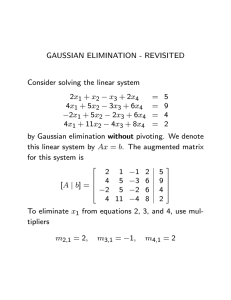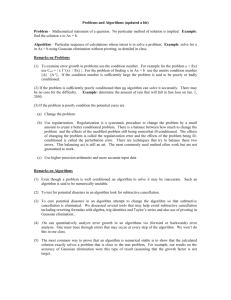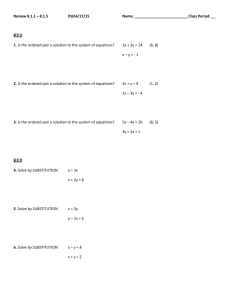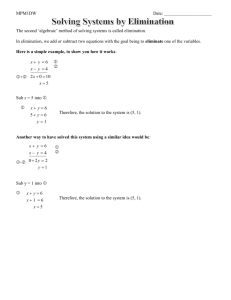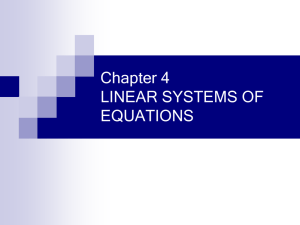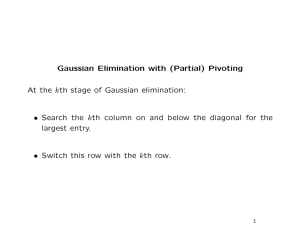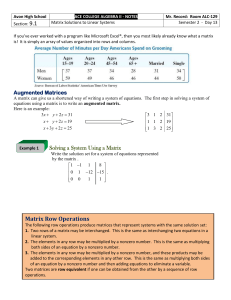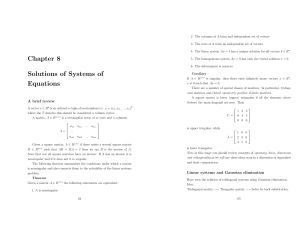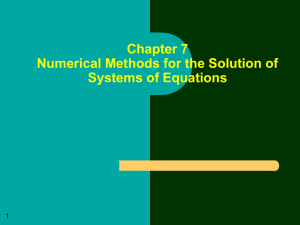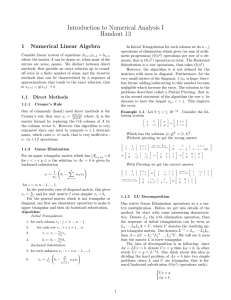Gaussian Elimination & LU Decomposition Explained
advertisement
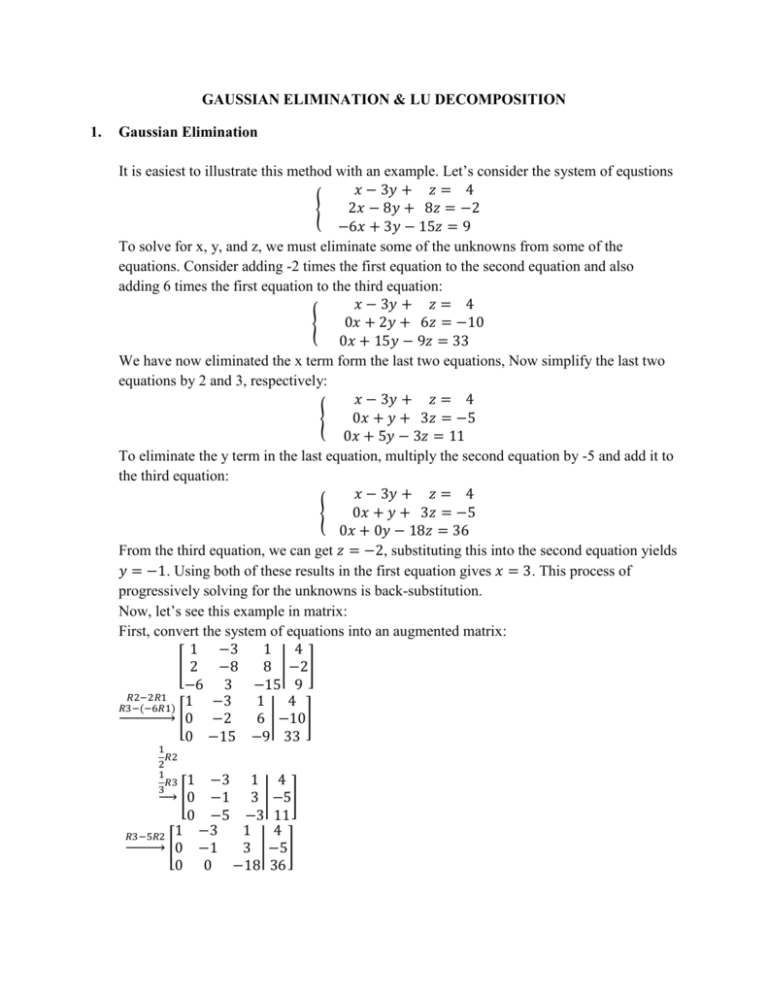
GAUSSIAN ELIMINATION & LU DECOMPOSITION
1.
Gaussian Elimination
It is easiest to illustrate this method with an example. Let’s consider the system of equstions
𝑥 − 3𝑦 + 𝑧 = 4
2𝑥 − 8𝑦 + 8𝑧 = −2
{
−6𝑥 + 3𝑦 − 15𝑧 = 9
To solve for x, y, and z, we must eliminate some of the unknowns from some of the
equations. Consider adding -2 times the first equation to the second equation and also
adding 6 times the first equation to the third equation:
𝑥 − 3𝑦 + 𝑧 = 4
0𝑥 + 2𝑦 + 6𝑧 = −10
{
0𝑥 + 15𝑦 − 9𝑧 = 33
We have now eliminated the x term form the last two equations, Now simplify the last two
equations by 2 and 3, respectively:
𝑥 − 3𝑦 + 𝑧 = 4
0𝑥 + 𝑦 + 3𝑧 = −5
{
0𝑥 + 5𝑦 − 3𝑧 = 11
To eliminate the y term in the last equation, multiply the second equation by -5 and add it to
the third equation:
𝑥 − 3𝑦 + 𝑧 = 4
0𝑥 + 𝑦 + 3𝑧 = −5
{
0𝑥 + 0𝑦 − 18𝑧 = 36
From the third equation, we can get 𝑧 = −2, substituting this into the second equation yields
𝑦 = −1. Using both of these results in the first equation gives 𝑥 = 3. This process of
progressively solving for the unknowns is back-substitution.
Now, let’s see this example in matrix:
First, convert the system of equations into an augmented matrix:
4
1 −3
1
[ 2 −8
8 | −2]
−6 3 −15 9
𝑅2−2𝑅1
4
1 −3
1
𝑅3−(−6𝑅1)
→
[0 −2
6 | −10]
0 −15 −9 33
1
𝑅2
2
1
𝑅3
3
1 −3 1 4
→ [0 −1 3 | −5]
0 −5 −3 11
4
1
−3
1
𝑅3−5𝑅2
→
[0 −1
|
3 −5]
0 0 −18 36
2. LU Decomposition
If A is a square matrix and it can be factored as 𝐴 = 𝐿𝑈 where L is a lower triangular matrix
and U is an upper triangular matrix, then we say that A has an LU-Decomposition of LU.
If A is a square matrix and it can be reduced to a row-echelon form, U, without interchanging
any rows , then A can be factored as 𝐴 = 𝐿𝑈 where L is a lower triangular matrix.
LU decomposition of a matrix is not unique.
There are three factorization methods:
Crout Method: diag (U) = 1; 𝑢𝑖𝑖 = 1
Doolittle Method: diag (L) = 1; 𝑙𝑖𝑖 = 1
Choleski Method: diag (U) = diag (L) ; 𝑢𝑖𝑖 = 𝑙𝑖𝑖
To solve several linear systems 𝐴𝑥 = 𝑏 with the same A, and A is big, we would like to
avoid repeating the steps of Gaussian elimination on A for every different B. The most
efficient and accurate way is LU-decomposition, which in effect records the steps of
Gaussian elimination. This is Doolittle Method.
Without pivoting:
𝐴𝑥 = 𝑏
𝐿𝑈𝑥 = 𝑏
To solve this, first we solve 𝐿𝑦 = 𝑏 for 𝑦 by forward-substitution method,
then solve 𝑈𝑥 = 𝑦 for 𝑥 by backward-substitution method.
With pivoting:
𝐴𝑥 = 𝑏
𝑃𝐴𝑥 = 𝑃𝑏, where P is permutation matrix.
𝐿𝑈𝑥 = 𝑃𝑏
To solve this, first we solve 𝐿𝑦 = 𝑃𝑏 for 𝑦 by forward-substitution method,
then solve 𝑈𝑥 = 𝑦 for 𝑥 by backward-substitution method.
The main idea of the LU decomposition is to record the steps used in Gaussian elimination
on A in the places where the zero is produced.
Let’s see an example of LU-Decomposition without pivoting:
1
𝐴 = [2
0
−2
3
−5 12 ]
2 −10
The first step of Gaussian elimination is to subtract 2 times the first row form the second row.
In order to record what was done, the multiplier, 2, into the place it was used to make a zero.
𝑅2−2𝑅1
→
1 −2
3
[(2) −1
6 ]
0
2 −10
There is already a zero in the lower left corner, so we don’t need to eliminate anything there.
We record this fact with a (0). To eliminate 𝑎32 , we need to subtract -2 times the second row
from the third row. Recording the -2:
𝑅3−(−2)𝑅2
→
1
−2
(2)
−1
[
(0) (−2)
3
6]
2
Let U be the upper triangular matrix produced, and let L be the lower triangular matrix with
the records and ones on the diagonal:
1 0 0
1 −2
3
𝐿 = [2 1 0] , 𝑈 = [0 −1
6 ]
0 −2 1
0 0 −10
Then,
1 0 0 1 −2
3
1 −2
3
𝐿𝑈 = [2 1 0] [0 −1
6 ] = [2 −5 12 ] = 𝐴
0 −2 1 0 0 −10
0 2 −10
Go back to the first example, rewrite the system of equation into matrix equation:
𝑥
4
1 −3
1
[ 2 −8
8 ] [𝑦] = [−2]
−6 3 −15 𝑧
9
1
−3
1 −3
1
(2)
−2
𝐴: [ 2 −8
]
→
[
8
(−6) −15
−6 3 −15
𝐴𝑥 = 𝑏
1
−3
1
1
(2)
−2
6
6 ]→[
]
15
−9
(−6) (− ) −54
2
1
0
0 1 −3
1
2
1
0] [0 −2
𝐴=[
6 ] = 𝐿𝑈
15
−6 − 2 1 0 0 −54
𝐿𝑈 − 𝐷𝑒𝑐𝑜𝑚𝑝𝑜𝑠𝑖𝑡𝑖𝑜𝑛
1
0
0 1 −3
𝑥
4
1
2
1
0
𝑦] = [−2]
[
]
[
]
[
0
−2
6
15
−6 − 2 1 0 0 −54 𝑧
9
𝐿𝑈𝑥 = 𝑏
1
2
0
0 𝑎
1
4
1
0 𝑎
[
]
[
]
=
[
2
−2]
15
−6 −
1 𝑎3
9
2
𝑎1
4
[𝑎2 ] = [−10]
𝑎3
108
𝑥
4
1 −3
1
𝑦
[0 −2
6 ] [ ] = [−10]
0 0 −54 𝑧
108
𝑥
3
[𝑦] = [−1]
𝑧
−2
𝑠𝑙𝑜𝑣𝑒 𝐿𝑦 = 𝑏 𝑢𝑠𝑖𝑛𝑔 𝑓𝑜𝑟𝑤𝑎𝑟𝑑 𝑠𝑢𝑏𝑠𝑡𝑖𝑡𝑢𝑡𝑖𝑜𝑛
𝑎1
𝑦 = [𝑎2 ]
𝑎3
𝑠𝑜𝑙𝑣𝑒 𝑈𝑥 = 𝑦 𝑢𝑠𝑖𝑛𝑔 𝑏𝑎𝑐𝑘𝑤𝑎𝑟𝑑 𝑠𝑢𝑏𝑠𝑡𝑖𝑡𝑢𝑡𝑖𝑜𝑛


